
The Aristolochiaceae are a family, the birthwort family, of flowering plants with seven genera and about 400 known species belonging to the order Piperales. The type genus is Aristolochia L.
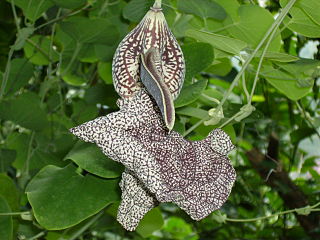
Aristolochia is a large plant genus with over 500 species that is the type genus of the family Aristolochiaceae. Its members are commonly known as birthwort, pipevine or Dutchman's pipe and are widespread and occur in the most diverse climates. Some species, like A. utriformis and A. westlandii, are threatened with extinction.

Battus philenor, the pipevine swallowtail or blue swallowtail, is a swallowtail butterfly found in North America and Central America. This butterfly is black with iridescent-blue hindwings. They are found in many different habitats, but are most commonly found in forests. Caterpillars are often black or red, and feed on compatible plants of the genus Aristolochia. They are known for sequestering acids from the plants they feed on in order to defend themselves from predators by being poisonous when consumed. The adults feed on the nectar of a variety of flowers. Some species of Aristolochia are toxic to the larvae, typically tropical varieties. While enthusiasts have led citizen efforts to conserve pipevine swallowtails in their neighborhoods on the West coast, the butterfly has not been the subject of a formal program in conservation or protected in legislation. The butterfly is however of "Special Concern" in Michigan, which is on the Northern limit of its range.
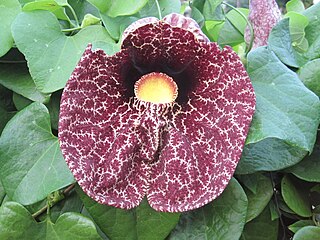
Aristolochia littoralis, the calico flower or مورپنکھ بیل orelegant Dutchman's pipe, is a species of evergreen vine belonging to the family Aristolochiaceae.

Aristolochia rotunda, commonly known as smearwort or round-leaved birthwort, is a herbaceous perennial plant native to Southern Europe.

Aristolochia labiata, the mottled Dutchman's pipe or rooster flower, is an ornamental plant which is native to Brazil.

Aristolochia amara is a species of plant in the family Aristolochiaceae.

Aristolochia westlandii is a species of plant in the family Aristolochiaceae. It is found in China and Hong Kong, in valley forests in Guangdong Province at an elevation of 300 to 800 metres. The leaves are long, narrow and pointed. The flowers are bent tubes from 10–15 centimetres (3.9–5.9 in) long that grow from the base of a leaf. They are yellow with purple veins and blotches.

Aristolochia acuminata, the native Dutchman's pipe or Indian birthwort is a poisonous perennial vine that is endemic to Asia and Malesia, New Guinea and the Solomon Islands and northern Australia.

Aristolochia didyma, or yawar panga is a plant found in South America of the genus Aristolochia. It is a powerful purgative, sometimes used in traditional rites to purify the body a few days before an Ayahuasca session.
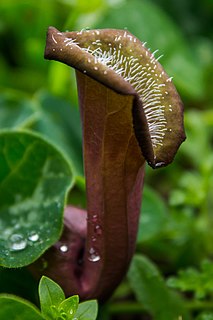
Aristolochia chilensis, known locally as orejas de zorro, is a herbaceous perennial plant native to Chile.

Aristolochia macrophylla, Dutchman's pipe or pipevine, is a vine native to the eastern United States. Aristolochia macrophylla belongs to the plant family Aristolochiaceae and is found primarily along the Cumberland Mountains and Blue Ridge Mountains in the eastern portion of the United States, as well as Ontario, Canada. This species of plant has received considerable attention in the past few decades for the discovery of a potent compound called aristolochic acid, which has been the focus of debate due its harmful side effects.

Aristolochia arborea is a species of perennial plant in the family Aristolochiaceae. It is found from Mexico through Guatemala and El Salvador.

Aristolochia gibertii is a species of perennial plant in the family Aristolochiaceae. It is found in Argentina, Bolivia, and Paraguay.

Aristolochia eriantha is a species of perennial plant in the family Aristolochiaceae. It is found in Bolivia.
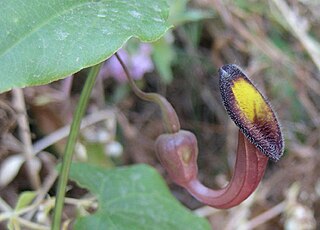
Aristolochia sempervirens is a species of perennial plant in the family Aristolochiaceae. It is found in the Eastern and Southern Mediterranean Basin, notably in Crete.

Aristolochia tricaudata is a species of perennial plant in the family Aristolochiaceae. It is found in Chiapas and Oaxaca, Mexico.
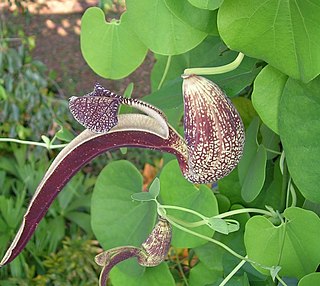
Aristolochia ringens is a species of perennial plant in the family Aristolochiaceae. It is found from Panama through Bolivia, Colombia, and Venezuela.

Aristolochia pontica is a species of perennial plant in the family Aristolochiaceae. It is found in the Republic of Georgia, Turkey, Lebanon, and Greece.

Aristolochia fimbriata is a species of perennial plant in the family Aristolochiaceae. It is found in Brazil, Paraguay, Bolivia, Uruguay, and Argentina. The flowering plant attracts butterflies and is known for its traditional medicinal properties.



















